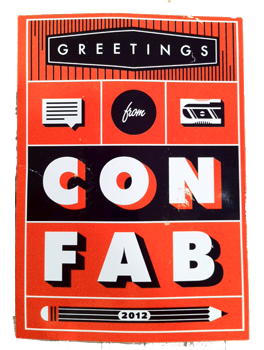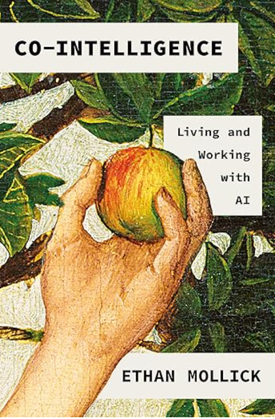Confab 2012: Thoughts and Reactions
 I recently attended Confab in Minneapolis. I was one of about 5 technical writers among the 650 attendees, which is why I found it surprising to hear Erin Kissane say, We can learn a lot from tech comm. Let me repeat that. We can learn a lot from tech comm.
I recently attended Confab in Minneapolis. I was one of about 5 technical writers among the 650 attendees, which is why I found it surprising to hear Erin Kissane say, We can learn a lot from tech comm. Let me repeat that. We can learn a lot from tech comm.
I felt pleased to hear this shout-out to my profession, and then tried to unpack exactly what she meant. Throughout the conference, a number of presenters emphasized the need for structured authoring. This refrain seemed loudest in Karen McGrane's talk on Adapting Ourselves to Adaptive Content (a presentation she is also giving at the STC Summit).
I believe they respect tech comm for our expertise in structured authoring, which theoretically gives rise to an ability to publish many different outputs from one source. If you can publish to web, mobile, tablet, flipbook, print, intranet, blog, white paper, social media, brochures, and other content from one source, because you've tagged that content in the right way, then you have a strong competitive advantage in the marketplace. Yes, "structured authoring is definitely the way to go" was the message I kept hearing.
If you want to write your content once and "spray" it (to use a verb I heard in Karen's presentation) to a dozen different publishing destinations, then you need to structure your content with the right tags, metadata, and other semantic markup to make it flexible and adaptable to the platform and context it resides on.
Despite all the enthusiasm for structured authoring, I didn't hear much about the nitty-gritty technical details. In fact, in one presentation, the speaker talked extensively about metadata, and had us map out a taxonomy for a website. The idea was that through metadata, the content management system (CMS) would dynamically pull content into various spaces on the website based on the metadata and content model rules.
I guess sticking with concepts is fine, but I would have appreciated some refreshing realism about the difficulty of doing this. Does a CMS that pulls different objects based on metadata require about 100K and a team of programmers to implement? Or are we talking about something much simpler here?
And to write once, publish everywhere, do we have a dozen or so custom XSLT transforms to manipulate XML-tagged content into different outputs? From what I've heard, setting these transforms up requires developer-level expertise, and getting the PDF deliverable is so difficult that the most one can hope for is a plain-looking output that is merely acceptable rather than downright ugly. Or is responsive design the model instead?
Two words I didn't hear
The Confab conference had many top-notch sessions. I listened to Lou Rosenfeld, Jared Spool, Mailchimp content strategists, and other well-known people. Their sessions were lively and memorable. However, I must confess that I was disappointed not hear the words "collaborative authoring" or "blog" during any presentation (except maybe as a brief word on a slide).
Why are these two concepts downplayed? First, I do not think the content strategists who attend Confab have any interest in wikis or collaborative authoring. From what I can tell, most attendees are content strategists in their organization, which usually means they write/edit/review the copy for their organization's website and other collateral, provide a style guide, and help in myriad other undefined ways. (To be honest, I'm always a little curious to hear what people who call themselves content strategists actually do in their organizations.)
I can understand the absence of discussion around wikis, because wikis are more the domain of tech comm. Wikis are more suited for technical publishing, when you regularly interact with subject matter experts, work with constantly changing information, follow an agile methodology, and draw knowledge from product users. Wikis are not typically for marketers.
But why no discussions about blogging? In fact, no sessions scheduled for the STC Summit address blogging either. What happened to blogging? Is it simply aggregated into a larger umbrella of social media? Is blogging now just considered another form of content? Or has the unthinkable happened -- has blogging become ... passé?
It wasn't too long ago that it seemed blogs were discussed more directly, and as a powerful, new form of content, rather than simply another form of social media. Where else can you publish thought-provoking, idea-soaked content with a personal voice and transparent tone? Few forms of content do more to build relationships, increase visibility, and spur interaction than a well-written blog. After all, not to call attention to myself, but MindTouch did name me #1 most influential in tech comm this year -- not for my content strategy, or for any books I've written (which I haven't), or for a preponderance of tweets, or for speaking engagements, or webinars, but rather for my blog.
And yet, ironically, having a blog nowadays doesn't have nearly the impact it used to. Now pretty much everyone has a blog, even though they may not post to it more than quarterly. And the quality of the posts? If it's a blog, it seems you're allowed to drop the quality several notches. You don't even need to proofread or spell check your content, really. It's just a blog. Synonymous with blah.
In one session, Erin Kissane presented a session on "Ideas Worth Stealing." She looked at innovations in writing and reading. Near the end, she mentioned a new site she has developed called Contents. Contents is an online magazine focused on content strategy.
From what I can tell, the style follows a similar approach as A List Apart. The site runs on WordPress, has a weekly publishing schedule, favors longer articles, probably includes an editorial workflow, has a list of regular contributors/editors, and is packaged in a responsive theme (making it mobile/tablet friendly).
Now, in looking at Contents, how is it really different from a group blog? One point Kissane made during her presentation is that lines and boundaries of content are blurring. What does it even mean for a book to be a book, now that you have mobile versions, online web versions, flipbooks, and so forth? What defines content as a book in this digital age? How does a blog post differ from a magazine article? Maybe it's better just to refer to it all as "content."
I like Kissane's style, and I definitely welcome the new Contents magazine. I just don't want us, in all this talk and praise of content, to forget about blogs.
Vivid = Verbal + Visual Interdependence
Let's switch gears a bit. Another major focus during Confab was the emphasis on adding visuals to content. Dan Roam gave one of the most energizing keynotes I've listened to for a while. It was one of those keynotes where something clicked inside of me.
I used to be more gung-ho for visual illustration (see my 10 post series on visual imagination). During Dan's presentation, I kept thinking back to my post on VITA (Video - Illustration - Text - Action) as my answer to the evolution of how one should do help content.
Somehow, in the busy-ness of life, I'd forgotten about the importance of visual content. Dan Roam reminded me of what I'd forgotten. Thank you, Dan. I was also pleasantly surprised to find a complimentary copy of Dan Roam's latest book, Blah Blah Blah: What To Do When Words Don't Work in my free Brain Traffic tote bag. (The conference staff really knows how to put together a nice conference.)
Dan's main premise is that you must combine the verbal (words) with the visual (pictures) to make your ideas vivid (hence the acronym).
I also attended a session on comics by Kevin Cheng. Comics are just sequentially told visuals, usually in story form. Kevin continued some of the points Dan made, but applied them in different ways.
If I were to combine more visuals with my writing, the appeal of my content would triple. The tragedy of tech comm is that we've focused too much on authoring efficiency over the past decade, rather than trying to solve the problem of why so many users find help useless. If help were more visual (and I'm not just talking about inserting more screenshots), both with the illustration of concepts and with videos, I think users would welcome help material, arms wide open.
By the way, I think some of Roam's ideas about connecting text with visuals ties back to Robert Horn's Visual Language: Global Communication for the 21st Century. More on that later (when I finish reading Blah Blah Blah).
On the Ride Home
On the ride home, I thought I was done with Confab, but the flight attendant saw my Brain Traffic tote bag and, somewhat stunned, asked, "What's that about -- Brain Traffic?" I thought a minute, and then said, "It's a writer's conference." (Who wants to explain content strategy to a flight attendant?)
Well, it turns out the guy sitting next to me was a Confab conference attendee, returning to Colorado. We chatted for about an hour. He had a lot of great insights and feedback about the conference. One of his criticisms was a lack of dissent during the conference. Few people disagree about anything, he noted. And you know what? He's right. I'm starting to get sick of tweets and blog posts that do nothing more than agree, praise, repeat a quote, and bemoan how others in their organization don't get it.
What exactly would you disagree with, I asked? He mentioned Ann Rockley's talk on governance. In the web publishing world of his clients, implementing a governance board that meets regularly to review content guidelines would be something his clients would downright laugh at. They have a need to publish immediately and regularly, without any kind of structure that introduces more bureaucracy into the system. Many of these companies aren't big enough to merit a "governance board."
He also pointed out that the idea of writing once and publishing everywhere was a flawed idea. You can't publish the same content that was intended for a blog post in a white paper, a tweet, and a brochure, he explained. Different forms require a different emphasis, style, and approach. To think that you can create content that can live everywhere and anywhere because you've tagged it intelligently is nonsense. It doesn't fit the world I live in.
We then got to talking about some of his projects. He is in fact a bonafide content strategist, and has begun his own company doing content strategy. He quit his regular job to do this, and has had good success so far, since the competition is scarce in his area.
With one of his clients, he explained that they publish regular blog articles to attract new readers. Readers are pulled in by the blog articles, and they are then presented with contextual links for the services the client sells. He said it has been a very successful strategy for the client. He didn't think blogs were passé, and he was a little surprised that blogs didn't receive more attention at the conference (though he hadn't considered this until I pointed out their absence).
Concluding thoughts
Overall, Confab is an excellent conference. Other attendees compared it to conferences put on by A List Apart. I walked away with a lot of insights and ideas, and I have been very open in this post. In the coming weeks, I'll try to post some notes from sessions I attended.
If this conference weren't back to back with the STC Summit, I would recommend that more technical writers attend it. If you're interested in learning more about content strategy, I recommend that you attend the Content Strategy Workshop that dovetails with Lavacon in the fall.
About Tom Johnson

I'm an API technical writer based in the Seattle area. On this blog, I write about topics related to technical writing and communication — such as software documentation, API documentation, AI, information architecture, content strategy, writing processes, plain language, tech comm careers, and more. Check out my API documentation course if you're looking for more info about documenting APIs. Or see my posts on AI and AI course section for more on the latest in AI and tech comm.
If you're a technical writer and want to keep on top of the latest trends in the tech comm, be sure to subscribe to email updates below. You can also learn more about me or contact me. Finally, note that the opinions I express on my blog are my own points of view, not that of my employer.

